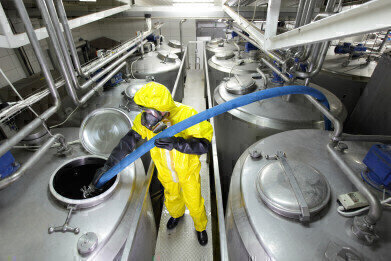Gas Detection
CO2 Gas Hazards in the Brewing Industry
Jul 25 2013
The hazards associated with CO2 in the brewing industry are well known, yet people still die needlessly every year in tragic and completely avoidable accidents in breweries. Just last year in Germany, which has a good safety record, two workers died in separate incidents at the same brewery.
Chris Wilson, Crowcon’s (UK) Senior Support Engineer, discusses these incidents and explains how they could have been avoided by following the right CO2 gas safety procedures.
CO2 is extremely hazardous and can kill in two ways: either by displacing O2, leading to rapid asphyxiation, or as a toxin in its own right. Exposure to as little as 0.5% volume CO2 represents a toxic health hazard, while concentrations greater than 10% volume can lead to death. Because CO2 is completely odourless and colourless there is no physical indication of danger until it is usually too late.
CO2 is a by-product of the fermentation process and, because the gas is heavier than air, it collects at the bottom of containers and confined spaces such as tanks and cellars and can even spill out of fermenting tanks and sink to the brewery floor, where it forms deadly, invisible pockets. In fact, CO2 is a hazard throughout the brewing process, right through to packaging and bottling.
Fermentation tanks, beer mixing tanks, silos and other confined spaces in the brewing industry are easily accessible – it is rare for them to be fitted with safety interlocks. For this very reason rigorous safety systems should be in place and always adhered to. Employers must assess the risks these areas pose to their employees and endeavour to prevent them. In most cases, both the assessment and the safe working system will require testing of the atmosphere with gas detection equipment.
As a rule, entry should not be routine and should only be carried out if absolutely necessary. However, if entry is necessary – for example for an inspection or to ensure cleaning has been carried out correctly – suitable safety procedures must be followed.
Firstly, CO2 from the space must be completely removed. This can be done by discharging all the fermentation and pressure gasses directly into the open air using a ring main system. If this is not possible due to the layout, the CO2 must be manually extracted and safely diverted.
Prior to entering a tank or other confined space, a ‘release measurement’ of CO2 must be taken using a suitable CO2 monitor. This is the only reliable method to check whether the CO2 concentration is actually at a safe level. The measurement must be taken by a qualified person, usually by lowering the monitor into the chamber and leaving it there for several minutes. It goes without saying that any monitoring device must be durable, reliable and regularly calibrated and tested.
Anyone entering a tank or other confined space must also be equipped with a suitable gas detector. If a certain CO2 concentration is exceeded the device will go into alarm mode with both audio and visual alarms.
Generally, at a CO2 volume of 0.5 % by volume, a pre-warning is set off; at 1 to 2 % by volume the main alarm is activated. With most devices other alarm thresholds can be selected with the aim of avoiding the alarm sounding too frequently and simultaneously ensuring the safety of the person working in the container.
Both portable and fixed CO2 detectors can be used for CO2 monitoring in breweries. Fixed systems typically comprise one or more detector "heads" connected to a separate control panel. If a detector reads a dangerous CO2 level, extractor fans are automatically triggered and sirens or visual beacons can also be activated to warn workers to vacate the area. This sort of installation is suited to larger spaces like cellars and plant rooms.
However, much confined space work in the brewing industry takes place in more restricted areas like fermentation tanks where fixed detectors cannot be installed. This means compact portable units are required. Ease of use, with one button operation, should be the norm when it comes to portable detectors. This means minimal training is required while increased safety is ensured. Combining one or more sensors with powerful audible and visual signals to warn when pre-set gas levels are reached, compact portable detectors are easily carried in a confined space, ensuring that pockets of high CO2 concentration are not missed.
Certain features should be expected in every portable CO2 detector. Clearly, life-saving tools for demanding environments must be as tough as possible, with reliable electronics housed in impact-resistant casings. While the need to leave gas sensors exposed to the atmosphere means that no instrument can be fully sealed, a high degree of protection against dust and water ingress is essential. Toughness notwithstanding, a well-designed detector will also be light and compact enough to wear for an entire shift.
Finally, because of the difficulties of working in a cramped space, perhaps under poor lighting, instruments should be easy to use. No matter how advanced a detector's internal architecture or data management options, personnel in the field should be faced with nothing more daunting than a clear display, simple, one-button operation and loud/bright alarms.
Not taking the risk of CO2 seriously has led to many unavoidable deaths. If all the safety procedures described above are observed, the risks of dealing with this colourless, odourless and tasteless gas can be significantly reduced.
Digital Edition
IET 34.2 March 2024
April 2024
Gas Detection - Biogas batch fermentation system for laboratory use with automatic gas analysis in real time Water/Wastewater - Upcycling sensors for sustainable nature management - Prist...
View all digital editions
Events
May 13 2024 Munich, Germany
May 15 2024 Lund, Sweden
May 15 2024 Frankurt-am-Main, Germany
May 20 2024 Columbus, OH, USA
May 21 2024 Lagos, Nigeria


















